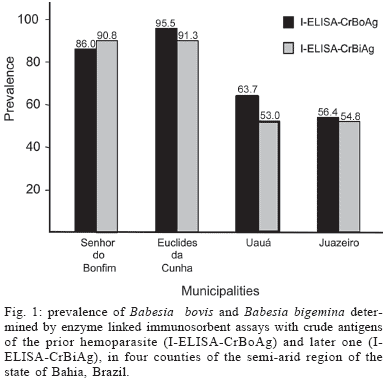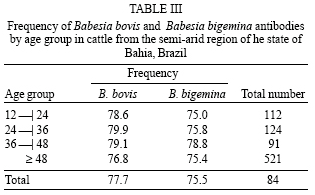The objectives of this work were to determine the prevalence of Babesia bovis, Babesia bigemina, and Anaplasma marginale detecting antibodies in cattle raised in the semi-arid region of the state of Bahia, Brazil, through indirect enzyme linked immunosorbent assays (ELISA) and to compare the performances of indirect enzyme-linked immunosorbent assays with crude (I-ELISA-CrAnaAg) and recombinant major surface protein-5 (I-ELISA-MSP-5Ag), as antigens to detect antibodies against A. marginale. An stable enzootic area was found in Senhor do Bonfim and Euclides da Cunha for B. bovis that showed 86 and 95.5% of prevalence, respectively, and for B. bigemina with 90.8 and 91.3%. On the other hand, Uauá and Juazeiro, were characterized as enzootically unstable areas, since prevalences were: B. bovis - 63.7 and 56.4% and B. bigemina - 53 and 54.8%, respectively. The prevalence of A. marginale in the four municipalities was above 97% with I-ELISA-CrAnaAg and 94.8% with I-ELISA-MSP-5Ag which is an indication of stable enzootic condition for the rickettsia. The I-ELISA-CrAnaAg and I-ELISA-MSP-5Ag showed a highly significant association (r = 0.977), which means that both ELISA tests are suitable for epidemiological studies of A. marginale.
Anaplasma marginale; Babesia bovis; Babesia bigemina; ELISA; prevalence; semi-arid; Brazil






